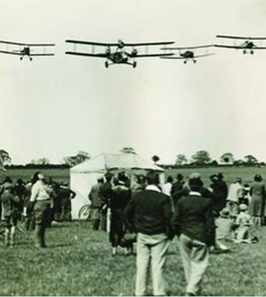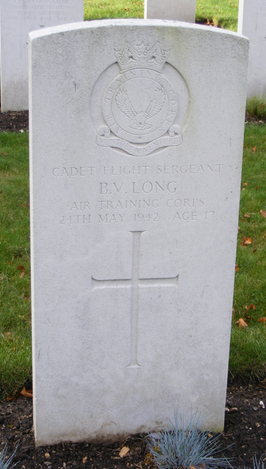Part 2: Causes and Accidents
In both world wars thousands of pilots were killed whilst undergoing flying training. All Royal Flying Corps training deaths in the UK have been listed and the numbers are appalling. In 1917 522 planes crashed but the 1918 figures are far worse. 1164 planes were lost in July 1918 alone, 150 fatal accidents occurred.
Mid-air collisions were common, engines caught fire and many failed to pull out of a spin. Several pilots were struck by the propeller whilst attempting to start the engine. Another pilot showing off by doing low level stunts crashed on the runway killing himself and three airmen standing near the runway. Another pilot mistakenly fired his Very Light inside the cockpit. In winter months fog and mist caused many fatalities as pilots got lost and confused and failed to find the aerodrome. Engine failure over the sea was also fatal in many cases. It must also be remembered that many other flying accidents occurred overseas in France, Belgium, Italy, Palestine, Mesopotamia and India.
World War Two training losses are little better. 8303 were killed either in the UK or overseas as part of the Empire Training Scheme in Canada, S Africa, Rhodesia and from 1942 the United States. The UK is awash with small memorials commemorating crashes on high ground in areas like the Pennines, Snowdonia, the Scottish Highlands, the North Yorkshire Moors and Dartmoor. Poor navigation resulted in many fatalities as planes got lost and ran out of fuel. Many planes used for training were ‘clapped out’ survivors of Bomber Command operations. Mid air collisions were not uncommon during the mass raids on German cities. Bad weather - fog, ice, snow and gale force winds during the winter months were obviously hazardous whilst the heavy bomb loads meant disaster on take-off if the engines misfired.
Twenty three men from my old school in Cambridge lost their lives as a result of unexpected air accidents. The youngest, Bryon Vernon Long was only 17 years old. He left school in the summer of 1941 having taken his School Certificate. He remained a keen member of the Cambridge Air Training Corps. In May 1942 he was offered the chance of a short training flight in Wellington bomber based at Newmarket.
The plane was taking part in a training exercise to practise the use of a cine-camera gun in fighter affiliation. Soon after take off a fault developed in the main spar which affected the outboard starboard engine. The plane rapidly span down out of control and crashed near Stanton, 6 miles east of Bury St Edmunds. All 9 crew on board were killed.
Likewise the oldest Old Churcherian to be killed in the Second World War was 45 years old Flying Officer Arthur Harold Rawson. After serving as a pilot in the First World War, he stayed in the RAF after the war and later became a member of Alan Cobham’s Flying Circus. Too old for active service, in 1939 he was employed as an instructor. He was killed in North Wales whilst flying from Penrhos aerodrome near Pwllheli. He was flying a Henley Mark 1 towing a drogue used for anti-aircraft gun practice over the local range. Engine trouble developed and whilst attempting a forced landing the aircraft stalled at a low height only 400 yards from Towyn aerodrome. The crash investigators reported that it was probable that the pilot was overcome by fumes caused by a glycol leak. Also killed was the wireless operator A/C Alfred Sharp. The inquest reported ‘death from shock due to burns’.
Inexperience and pilot error often resulted in accidents and this is well illustrated by Pilot Officer Raymond Johnson who was killed in September 1940 whilst flying from Thorney Island engaged in flying patrols over the English Channel.
Sadly he was killed on his first operational flight flying a Blenheim bomber to the coast of Brittany. Nothing was seen but on the approach to land back at Thorney the aircraft suddenly stalled and crashed into the sea at the entrance to Chichester Harbour. Johnson was killed but his two crew members survived and were rescued by Selsey lifeboat. It seems that a combination of inexperience and pilot error caused the crash. Johnson’s grave can be seen in St Nicholas Churchyard on Thorney Island.
John Symonds
Since writing this article John has very sadly passed away.
The Service in Celebration of his life has had to be postponed to a later date due to the COVID-19 Pandemic.
John has been an ardent supporter of St George’s News, having contributed articles not merely over years, but over decades and he will be greatly missed by the magazine as well as by all his family and many friends.
A full tribute will be published in a future issue of St George’s News after the Celebration Service has taken place.








